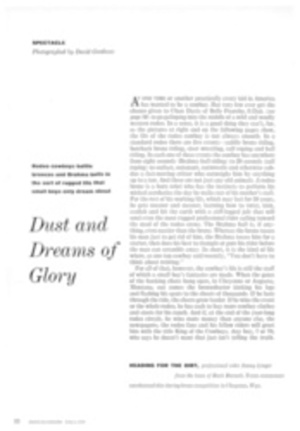
Lunch in Cuernavaca
The town of Cuernavaca lies in an atmosphere of luminous haze and ancient memories on a plateau some 40 miles south and 3,000 feet closer to sea level than Mexico City. It is a country town full of flowers and trees, singing birds and running water, where villas seem to be dreaming in the privacy of their walled gardens and time can be forgotten. The rulers of Mexico have been coming to Cuernavaca ever since the days of the Indian kings to find relaxation away from the pressures of life in Mexico City. And the place has swallowed up the conquerors—Aztec, Spaniard and Austrian alike. The Rivera murals that mock the conquest are fading in the castle Cortes built, and mangoes have crumbled the terraces of the romantic Borda Gardens where Maximilian's ghost must walk.
When I visited Cuernavaca recently, I thought of Sybille Bedford's description of it in her fine book on Mexico, The Sudden View: "The sky was flawless, and, swimming, one could see the snows of two volcanoes." There they were, Popocatepetl and Ixtaccihuatl, indescribable snow peaks riding as high and as lightly in the midday firmament as clouds. We had been fortunate enough to be asked to lunch with Don Juan de Ortiz Monasterio and his beautiful wife, Doña Carlota de Uguarte de Ortiz Monasterio, who were weekending at their country house. We swam in a turquoise pool overshadowed by palm trees and afterwards wandered peace-fully in a delicious garden among jacarandas, zapote trees and embowering bougainvillaeas. "Do you wonder," Doña Carlota said, "that we love it here?"
In town the Monasterios are active in civic and social affairs, and Doña Carlota, a Spaniard of aristocratic birth, entertains frequently at their house in the elegant Lomas district of Mexico City. Guests as often as not include visitors from the United States. Genial, popular Juan Monasterio, whose mother was an American, spent part of his youth north of the border and is a graduate of Tulane. Today a widely known international banker and financier, he told me with a laugh about his first job in a bank, which was in New Orleans. "Every day," he said, "I took the streetcar called Desire, on the street called Desire."
At his Cuernavaca property, to which the Monasterios retreat with their children as often as possible, Don Juan keeps three Thoroughbred saddle horses. A passionate horseman, he loves nothing more than an early morning ride with his 8-year-old daughter, to be followed by almuerzo, the Spanish second breakfast, which he allows himself only on weekends. The day we arrived, toward noontime, he made a special point of leading his guests first to the paddock to admire Toody-Pan, Yo-Yo and Circus Man. After this a swim, and our host served us a wonderful drink that he calls a Monasterio—composed of white Bacardi rum and Italian sweet vermouth, roughly half and half, poured over ice in an old-fashioned glass. Then, on the terrace of the cool, shade-filled house—some of its walls frescoed with leafy patterns, as can be seen in the picture—we were served a most delectable comida (midday meal).
Here is what Doña Carlota gave us on that happy day: guacamole, a preparation of alligator pear, heaped in a ring of cold rice and served with a basket of paper-thin, homemade tortillas; huauchinanguito (breaded red snapper) with vegetables and chili sauce; and mango ice cream. Given below is the Monasterios' household recipe for a Mexican national dish which is a delightful summer treat.
GUACAMOLE
There are approximately as many versions of guacamole as there are cooks in Mexico. This one, presented in a ring of rice, is particularly delicious. The recipe serves twelve.
For the rice ring, thoroughly rinse 5 cups of unprocessed rice, then throw into 9 quarts of boiling water containing 2 tablespoons of salt. This is best done in two pots. Boil uncovered for approximately 20 minutes. Drain; rinse well under cold water tap. Oil a 1½-quart-capacity mold (or two 3-pint molds) with olive oil. Pack rice firmly in molds. Chill in refrigerator.
For the guacamole itself, you will need 8 large, ripe alligator pears; 8 tablespoons of olive oil; 2 medium onions, minced into tiny dice; a handful of slightly wilted leaves of coriander, minced (or, as a substitute, a handful of fresh parsley leaves, stems removed, minced extremely fine and combined with 3 tablespoons of coriander seeds—available in spice shops—the seeds pounded to a coarse powder with a potato masher or other instrument in a wooden bowl). Tabasco sauce, salt and a couple of lemons also are required.
The procedure is to mix the minced onions and herbs together with the olive oil in a bowl, then cut the peeled alligator pears into large dice with a silver knife, squeezing lemon juice over them so the fruit will not darken. Combine all together, and season with about 2 teaspoons of salt and Tabasco to taste.
Unmold the rice ring on a round serving dish. Pile the guacamole in the center. Serve with hot tortillas.
PHOTO
N. R. FARBMAN—LIFE
ON THE TERRACE of his lovely villa south of Mexico City, Don Juan de Ortiz Monasterio, with his wife Doña Carlota at left, prepares to serve guacamole at a marble luncheon table.

